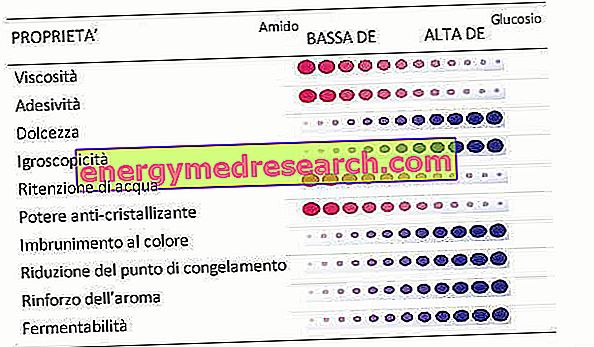What are
Peaches in syrup are long-term foods that belong to the whole of the preserved fruit and fruit in syrup subset.

Peaches, like all fresh fruits, belong to the VI-VII fundamental group of foods - fruits and vegetables rich in vitamin A and vitamin C. However, once processed for processing into "preserves" - washing, peeling, pitting, cooking and invasions in a sweet liquid - they no longer have the same nutritional characteristics as fresh fruit. Chemically speaking, they are richer in soluble / simple sugars but contain fewer thermolabile vitamins. This makes them very caloric and has a high glycemic-insulin load and index; they are therefore not very suitable for clinical nutrition, especially for overweight, type 2 diabetes mellitus and hypertriglyceridemia. Note : to improve conservation, in the industrial environment they are enriched with antioxidant additives - especially vitamin C or ascorbic acid, like the many types of ascorbate.
The recipe for peaches in syrup is quite simple. The necessary step for preservation is cooking and potting with sterilization; the most important step to obtain a perfect consistency in the long term is certainly the formulation of the syrup.
In the kitchen, peaches in syrup are mainly used as a dessert, sometimes accompanied by whipped cream and / or liqueurs and / or chocolate flakes and / or biscuits - even crumbled. It is advisable to eat them away from the main meals, so as not to reach too high a glycemic load. They can be a snack or an ingredient in breakfast. There are several recipes that contain peaches in syrup, even if on average they are all excessively caloric to be able to constitute an ordinary diet; a classic example is the peach melba, but they are used for different cakes - above all cold - and spoon desserts.
Why syrup peaches?
The invention of peaches in syrup is due to the need to prolong the preservation of ripe fruits, excessively available in a limited period of time. Jams and jams, jellies, candied or candied fruits - such as citron - and the dehydrated one also have "more or less" the same goal. The production of jams and jams represents the "last resort" of the harvested and overripe fruit, perhaps dented, marked by mold or vermin, and therefore unsuitable for the production of syrups. For the candied and dehydrated one, the matter is different, since it requires raw materials that are still intact and a higher expenditure of energy and resources. In the past, the surplus of the summer harvest of peaches was therefore destined to these transformations, which guaranteed their availability throughout the winter period. The intact fruits were then in syrup, while those dented, partially moldy, vermin or in any way to clean and clean, were transformed into jam or jam - or fruit purée, to be eaten fresh.
Nutritional Properties
Nutritional properties of peaches: fresh VS in syrup
Being rich in vitamin A - especially retinol equivalents (RAE), or carotenoids - and vitamin C - ascorbic acid - peaches are framed in both the VI and VII fundamental food group.
Raw and fresh, they have a moderate energy supply and an excellent percentage of water. Calories are provided mainly by soluble / simple sugars, or fructose monosaccharide; proteins - with a low biological value - and lipids are marginal. They contain a good amount of dietary fiber. Note : The presence of fructose - instead of glucose, sucrose or maltose - and fiber helps to define a medium-low entity glycemic-insulin index.
Instead, they are cholesterol free. No traces of lactose, gluten or histamine are detected. They have a low level of purines and phenylalanine amino acid. The amount of minerals, especially potassium, is satisfactory. As for vitamins, in addition to equivalent retinol - carotenoids - and vitamin C, the dose of folic acid is more than fair. Note : The intake of retinol equivalents (RAE) changes significantly based on the variety of fishing.
Peaches in syrup, on the other hand, have a much higher energy intake, almost double compared to the fresh raw ingredient. The extra calories are supplied by sugar - disaccharide sucrose or monosaccharides glucose and fructose - used for syrup. Proteins and lipids have even less relevance than fresh fruits. Being peeled, peaches in syrup contain less dietary fiber; however, thanks to cooking, part of the latter undergoes partial hydrolysis, becoming more digestible and available to the intestinal bacterial flora - prebiotic function. However, cholesterol and lactose are absent; similarly, purines and phenylalanine appear in modest concentrations. With regard to histamine instead, it is reported that, in general, preserved foods tend to develop greater concentrations. The mineral profile tends to decrease, due to the dilution in the governing liquid. The same applies to the vitamin concentration which, moreover, is drastically reduced following cooking. This is not true for retinol equivalents (RAE or provitamin A), but for ascorbic acid (vitamin C) and folic acid - both thermolabile.

| Fresh Peaches | Peaches in syrup | |
| Quantity' | Quantity' | |
| water | - g | 81.1 g |
| Protein | 0.7 g | 0.5 g |
| Lipids | tr | tr g |
| Saturated fatty acids | - g | - g |
| Monounsaturated Fatty Acids | - g | - g |
| Polyunsaturated Fatty Acids | - g | - g |
| Cholesterol | 0.0 mg | 0.0 mg |
| TOT Carbohydrates | 5.8 g | 14.0 g |
| Starch / Glycogen | 0.0 g | 0.0 g |
| Soluble Sugar | 5.8 g | 14.0 g |
| Food fiber | 1.9 g | - g |
| Soluble | 0.78 g | - g |
| Insoluble | 1.14 g | - g |
| Power | 25.0 kcal | 55.0 kcal |
| Sodium | - mg | 4.0 mg |
| Potassium | - mg | 110.0 mg |
| Iron | - mg | 0.2 mg |
| Football | - mg | 3.0 mg |
| Phosphorus | - mg | 11.0 mg |
| Magnesium | - mg | - mg |
| Zinc | - mg | - mg |
| Copper | - mg | - mg |
| Selenium | - mcg | - mcg |
| Thiamine or vitamin B1 | - mg | 0.01 mg |
| Riboflavin or vitamin B2 | - mg | 0.01 mg |
| Niacin or vitamin PP | - mg | 0.6 mg |
| Vitamin B6 | - mg | - mg |
| folate | - mcg | - mcg |
| Vitamin B12 | - mcg | - mcg |
| Vitamin C or Ascorbic Acid | - mg | 5.0 mg |
| Vitamin A or RAE | - mcg | 13.0 mcg |
| Vitamin D | - IU | 0.0 IU |
| Vitamin K | - mcg | 0.0 mcg |
| Vitamin E or Alpha Tocopherol | - mg | - mg |
Diet
Peaches in syrup in the diet
The increase in glycemic load, total calories and glycemic-insulin index, make peaches in syrup an unsuitable food for the diet against overweight, hyperglycemia or type 2 diabetes mellitus and hypertriglyceridemia. They are also not recommended for people who frequently suffer from tooth decay. The fiber intake is discreet and could help meet the daily dietary intake. The fibers are essential to decrease the glycemic index, to increase the sense of satiety and to modulate intestinal absorption. They also have a beneficial effect on the intestine, improving alvo and preventing or treating a series of disorders and even serious pathologies: constipation, diverticulosis and diverticulitis, inflammation of hemorrhoids, anal fissures and anal prolapse; a high fiber diet reduces the incidence of some colon cancers. Provitamin A and vitamin C are two powerful antioxidants; folic acid, on the other hand, plays a necessary role in the synthesis of nucleic acids, which is why it is necessary in pregnancy. It is however necessary to consider that, with cooking, the thermolabile molecules - ascorbic acid and folic acid - undergo an irreversible degradation. Note : the addition of antioxidant additives in commercial products compensates, at least in part, for the reduction of vitamin C.
It must be specified that the excess sugar of peaches in syrup has a bad impact on the metabolism; moreover, especially for this reason, occasionally fairly small portions (50-100 g) must be eaten. For both these reasons, peaches in syrup cannot be considered a primary source of vitamins, minerals and dietary fiber.
recipe
Recipe of peaches in syrup
Below we will briefly summarize how to prepare peaches in syrup quickly and easily. To consult a more accurate source we suggest Alice's video recipe: "Peaches in Syrup" which you can also find in the following video:
Peaches in Syrup - Recipe to Prepare them in Safety
X Problems with video playback? Reload from YouTube Go to Video Page Go to Video Recipes Section Watch the video on youtubeIngredients of peaches in syrup
- 900 g of peaches
- 300 g of granulated sugar
- 135-140 ml water
- protective antioxidants (eg vitamin C).
Tools for preparing peaches in syrup
Knife, cutting board, glass jars and lids, pots and lids, twists or cloths and pot holders, hob.
Process of peaches in syrup
- Wash glass jars and lids
- Sterilize them in boiling water inside a muffler or saucepan
- Boil water in another pot
- Wash the peaches
- Blanch the peaches in the water for 30 "
- Drain and cool them in ice water
- Peel the peaches
- Cut them in half (or at pleasure), remove the seed and scrape off the surrounding red fibers
- Dip the peaches in the protector according to the instructions on the package
- Put sugar and water in another saucepan; bring to a boil
- Place the peaches in the jars and cover with the syrup by removing the air bubbles
- Place the lids on the jars without tightening them
- Put the jars back into the pot with the water for sterilizing the jars
- Bring to a boil and keep for 25-30 '"
- Remove the jars from the hot water and tighten the lids
- Cool and check the vacuum seal.
Frequent errors in preparing peaches in syrup
Peaches in syrup become swollen and soggy or small and hard with preservation
If the peaches in syrup become swollen and soggy it is certainly the fault of the syrup, in particular of its osmotic power - called "strength". If too concentrated, the syrup tends to dehydrate the fruit making it hard; if too diluted it pushes the water inside the plant tissues making them swell. The ideal strength of the syrup should be around 20 ° Baumé (proportion of bulk sugar), or 145-145 / S (S = specific mass of sugar). It is an equation that varies according to the osmotic power of the pulp used; it changes from one fruit to another, but the diversity is relevant only by changing the botanical species (for example by replacing peaches with grapes without peel). For more details, please read our article: Fruits in Syrup.
Peaches are not kept and fermented
If the peaches in syrup are not kept and fermented, the fault can be of two factors:
- Ineffective sterilization: failure to reach the temperature or for an insufficient time.
- Impairment of the hermetic seal: generally caused by a defect in the gasket or the shape of the cap.



